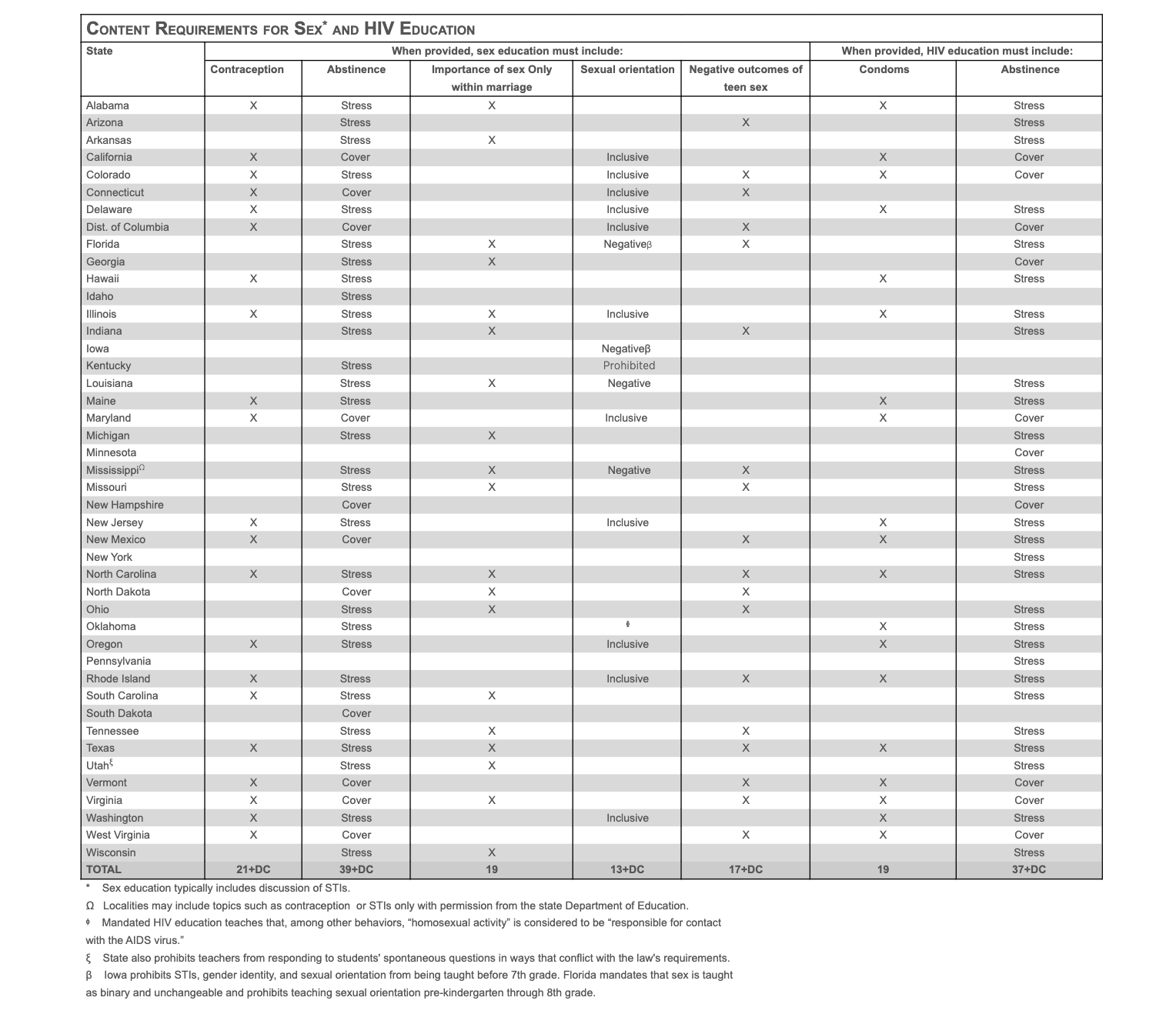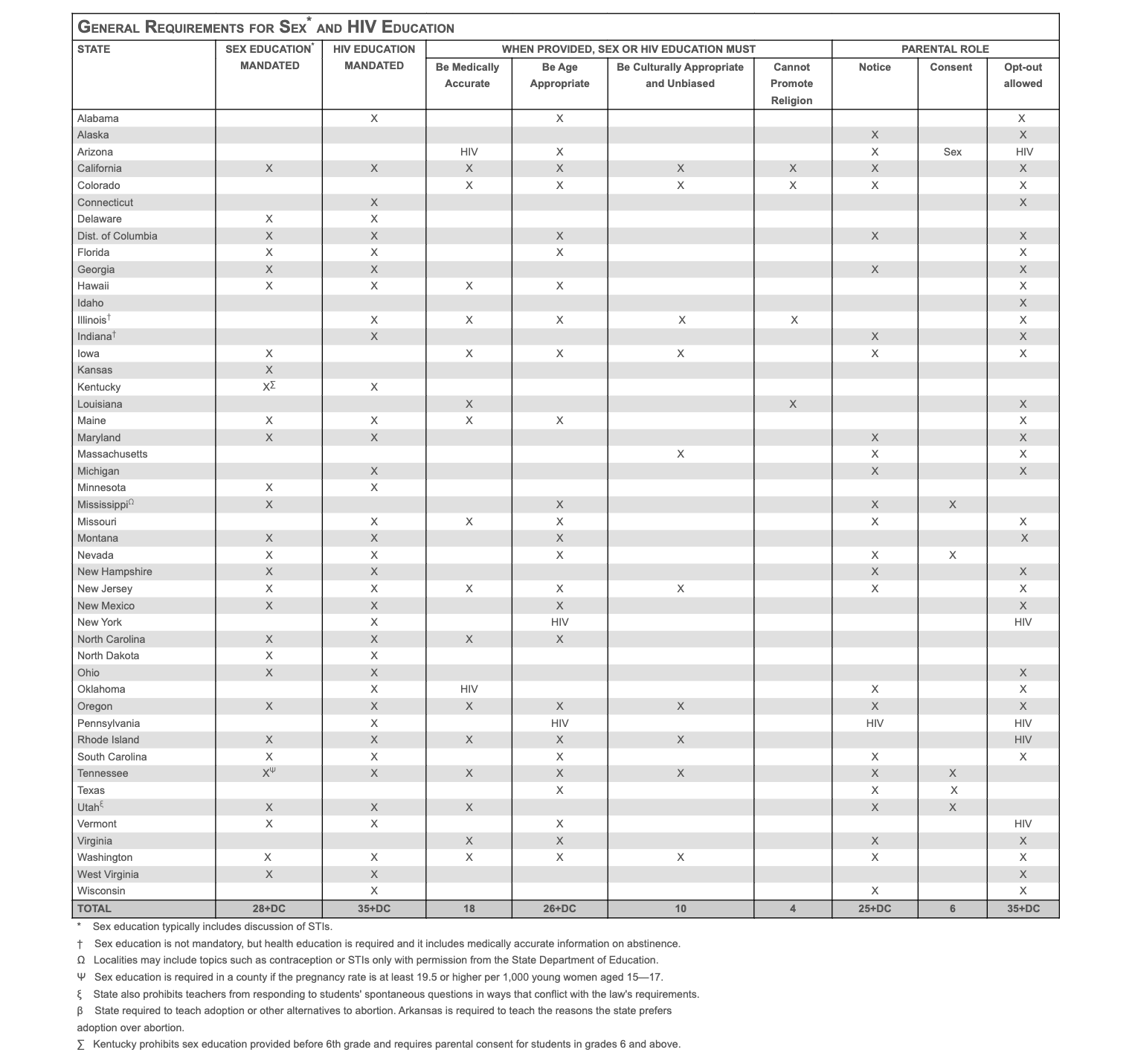Class Notes | Sex Education in the U.S.
⤏ WRITTEN AND RESEARCHED BY ANNA CARLSON OF SANTULAN CREATIVE
⤏ EDITED BY GISSELLE PERNETT
Class Notes is a recurring series exploring topics that we find hard to understand (purposefully or otherwise!). Started as Instagram infographics, Class Notes has shifted into a monthly Jr Hi the Magazine feature which you can read here!
⤏ Santulan is a kinetic creative agency + print publication based in Los Angeles and New York City. Santulan is a community of artists, creators, & strategists heralding from diverse backgrounds & and abilities (especially of lower equity), driven to well create dope a*s projects.
TERMS YOU SHOULD KNOW
Gender identity: An individual's chosen sense of self and gender.
Gender-fluid: A person who doesn’t identify with a fixed gender.
Gender expression: The external appearance of one’s gender identity through behavior, body characteristics, or clothing.
Gender binary: A social construct defining gender into two categories of male or female.
Gender-affirming care: Social, psychological, behavioral, or medical intervention aimed at supporting and affirming a person’s gender identity when it is different from the person’s gender assigned at birth.
Abstinence–only education: Also known as “abstinence-only-until-marriage” or “sexual risk avoidance,” these programs teach that abstinence is the only way to prevent STIs and pregnancy, and avoids discussion of abortions.
Abstinence–plus education: Teaches information on contraception, abortions, and STIs but continues to promote abstinence.
Comprehensive sex education: Teaches age appropriate information about sexuality, and sexual reproductive health. This program also includes information on consent, pregnancy, bodily autonomy, puberty and menstruation.
HB 1557: Commonly referred to as the “Don’t Say Gay” law, Florida’s Paternal Rights in Education Act banned instruction on sexual orientation, and gender identity in K–3 grade classrooms.
HB 1069: The expansion of the Paternal Rights in Education Act that:
Allows parents to object to any educational material they believe isn’t age appropriate
Prohibits all employees or contractors in public schools from providing students their personal pronouns if they do not correspond to that person’s sex
Students will not be asked to provide their preferred pronouns
All materials used to teach reproductive health or any STI must be approved by the Department of Education
Schools are required to teach that “biological males impregnate biological females” and reproductive roles are “binary, stable, and unchangeable.”
Pre-exposure prophylaxis (PrEP): HIV prevention medication that can be used by people of all gender identities, and sexual orientations. PrEP can be taken as a daily pill, injectable, or on an as-needed basis. This medication does not protect against other STDs.
HISTORY OF SEX ED
Before sex education was introduced to public schools there was “The Fatal Consequences of Masturbation” and a graham cracker, cornflakes diet designed to get people to stop masturbating. If you think sex education and the U.S. education system have a complex relationship now, wait until you hear how little has changed from the past.
In 1892, the National Education Association introduced “moral education” in schools —which basically meant religion, good! Sex, bad! But the idea of sex education wasn’t established until the early 20th century. Sex education courses were first introduced in a Chicago public high school in 1913 through a series of confusing pamphlets with limited information (like the pamphlets you would read about in the nurse’s office while you waited for them to check your temperature.) Much like today these pamphlets were met with resistance from religious, and conservative groups.
It wasn’t until World War I, a rise in infidelity, and a scandalous STI outbreak amongst American soldiers where the U.S. government began funding gonorrhea, and syphilis prevention programs. This caused a shift in public perception and in 1940 the U.S. Public Health Service stepped in and called for sex ed to be a necessity in public school curriculum. This led to the creation of the American Medical Association’s five part “Sex Education Series” which would set the standard for sex education at the time.
The expansion of sex education continued to face strong backlash from conservative, religious groups who wanted to stop all sex education in public schools because everyone knows if you stop teaching people about sex, they won’t have sex! Duh. Meanwhile, adults were concerned about the rise in adolescent pregnancies. By the 1980’s, there was an increase in support for sex education as more research proved that education didn’t necessarily promote sex. Shocker!
Sex education across the US progressed and included more lessons on human development, anatomy, contraceptives, and family life. Fear surrounding the AIDS epidemic strengthened sex education which was great! —except people still believed teaching abstinence was the best form of sex education. In 1986, the US Surgeon General issued a directive for comprehensive AIDS prevention and sex education classes to be taught in public schools beginning in third grade. This angered even more religious groups, who would go on to use the AIDS crisis as a launching pad for abstinence-only sex education, which is still a point of struggle amongst academic boards today.
THE CURRENT STATE OF SEX ED
It’s no secret teens have found sexual education to be uninformative and inadequate. Just think about the number of conversations you’ve had with friends about how awkward your “sex talk” was or how sex education was reduced to one class period in high school.
A study done by the Kaiser Family Foundation in 2000, surveyed over 1500 students, their parents, and 1300 educators to understand the gaps in sexual education. Many parents wished schools would offer more sex education for their children. For instance, the study found that 97% of parents wanted their children to learn about what to do if they had been sexually assaulted, while only 59% of students actually reported learning about sexual assault.
Though this study was done almost 24 years ago, the push for more comprehensive sex education is still relevant today. In 2023, the hormonal health company —Mira— surveyed 1500 Americans between the ages of 18–44 about their experience with sex education. According to the study, 90% of the surveyed population reported that sex education failed to provide them guidance. The survey also found that millennials and gen z were more likely to use online resources for sex education compared to traditional sex ed classes. The study further concluded that sex education was falling short when discussing first sexual experiences, communication with partners, LGBTQ sex contraception, and gender identity.
As of 2023, only 28 states and the District of Columbia mandate sex education while 35 states require HIV education, according to the Guttmacher Institute. There are three main types of sexual health programs: abstinence-only, abstinence-plus, and comprehensive sex education. Let’s break them down.
Abstinence-only programs are designed to teach students that it is “morally correct” for young people to abstain from sex until marriage. According to the Kaiser Family Foundation, these programs “usually exclude any information about the effectiveness of contraception or condoms.” While we can’t argue that abstinence isn’t the most effective way to prevent pregnancies and STIs, research provided by the Journal of Adolescent Health has proven abstinence-only programs do not prevent young people from having sex. Instead abstinence-only programs withhold important and possibly life saving information in regards to consent, unplanned pregnancies, and STIs. On top of shaming sexually active students, these programs are taught through a heterosexual, and monogamous lens and completely isolate students who are survivors of sexual assault.
Abstinence-plus programs are similar to abstinence-only programs as they “encourage abstinence but include information on contraception and resources available for sex practices,” according to the Board of Education.
Comprehensive sex education (the kind we’re rooting for!) gives students information on sexuality, and sexual and reproductive health. According to the World Health Organization, comprehensive sex ed covers “respect, consent, bodily autonomy, puberty, menstruation, contraception and pregnancy, and sexually transmitted infections.” These programs are tailored for different ages and cover a range of topics throughout childhood and adolescence.
WHERE DOES THIS LEAVE QUEER STUDENTS?
Currently, only 10 states and the District of Columbia have policies that include sexual orientation, LGBTQ identities, or an inclusive discussion of sexual health. As of September 2023, the Guttmacher Institute reports that four states still require only negative information to be provided on homosexuality, and one state prohibits the discussion of gender identity, expression, or sexual orientation. The worry is that the GOP will continue to pass legislation that targets LGBTQ students, and doing so will continue to create harmful dynamics in their everyday social lives and overall well-being. Queer students already account for feeling underrepresented in most aspects of their educational experience, and having their identities and expressions excluded from sex education has often required them to look elsewhere, increasing the chances of harmful misinformation.
Although anti-LGBTQ legislation regarding education is nothing new, Florida’s House Bill 1557 and 1069—known by the moniker “Don’t Say Gay"— has spearheaded a wave of similar bans targeting K–12 schools and aimed at censoring queer identities.
Officially signed into law in 2022, HB 1557 prohibited discussion and instruction about sexual orientation and gender identity in kindergarten through the third grade. Further instruction for students above the third grade is required to align with state standards and be deemed age-appropriate —though the law doesn't have a clear definition for “age-appropriate.” Additionally, the law gives parents the liberty of suing their child’s school for “alleged harm” if they believe discussions involving gender identity or sexual orientation have occurred. According to Human Rights Watch, the bill also prohibits schools from maintaining confidentiality, requiring them to notify parents of any physical, mental, or emotional changes in their child.
Following this, HB 1069 —an expansion of HB 1557— was passed in May of 2023. In addition to prohibiting instruction about sexual orientation and gender identity the new law:
Prohibits any instruction on sexual orientation and gender identity in K–8 classrooms unless the instruction is required for health lessons on sexual abstinence or HIV prevention in grades 6–8
Allows parents to object to any educational material they believe isn’t age appropriate
Prohibits all employees or contractors in public schools from providing students their personal pronouns if they do not correspond to that person’s sex
Students will not be asked to provide their preferred pronouns
All materials used to teach reproductive health or any STI must be approved by the Department of Education
Schools are required to teach that “biological males impregnate biological females” and reproductive roles are “binary, stable, and unchangeable.”
Additionally, the new law implements a policy in every K–12 school that establishes, a person’s sex as “an immutable biological trait” and continues to say it is “false to ascribe to a person’s pronoun that does not correspond to such person’s sex,” according to the National Education Association. Between 2021 and 2023, seven other states—Alabama, Arkansas, Indiana, Iowa, Kentucky, and North Carolina—have adopted similar restrictive laws, as reported by the SIECUS Sex Ed State Law and Policy Chart.
SEX AND HIV EDUCATION BY STATE
SEX AND HIV EDUCATION STATE LAWS AND POLICIES, Courtesy of the © 2023 Guttmacher Institute
WHAT COULD INCLUSIVE SEX ED LOOK LIKE?
LANGUAGE IS IMPORTANT!
Using safe and affirming language is the most important aspect of educating young people about sexual health. To aid in inclusive sex education, the curriculum should emphasize concepts and terms without assuming, or assigning genders. For example, when discussing hormonal birth control (implants, pills, and IUDs) rather than saying they are only for women, say hormonal birth control works for people with ovaries, or instead of referring to pads and tampons as feminine hygiene products refer to them as menstrual hygiene products.
The hallmarks of inclusive, and comprehensive sexual education establish personalization and sexual agency. Sexual education and health should mean safe sexual encounters for queer and heterosexual students alike. Alongside contraception and STI testing, resources for checkups that include gender-affirming care, and consent literacy should be readily available. In addition to the sex education curriculum, queer students should be informed of other risk factors, and provided with the tools to respond to sexual or gender discrimination. More examples that depict a range of body types and genders should be included in the lessons.
It’s easy to think of sexual relationships as the focal point of sex education, but still, the guidance of healthy relationships, building emotional connections, dating, non-sexual activities for both queer and heterosexual youths, and family planning outside of heterosexual relationships should be discussed.
LET’S GET GAYER!
Discussing pride and teaching the history of the LGBTQ movement doesn’t always guarantee students can feel seen, but it is a great starting point. There are invaluable lessons that can be drawn from teaching queer history to all students. Expanding the curriculum gives students a chance to learn about those in the community who pioneered before them and allows students to take inspiration from queer activists and icons. Simultaneously, teaching queer history to all students opens the floor to conversations about pride, allyship, and other LGBTQ topics, which can foster a new standard of acceptance toward queer students. From there, allyship can build into active cooperation for the greater good.
What can we do now?
WAYS TO ADVOCATE FOR INCLUSIVE SEX EDUCATION:
Join and participate in LGBT support clubs such as GSA (Gay-Straight Alliance)
Gather a group of students to attend district board meetings and push for inclusive sex-ed
Parents should educate themselves and talk to their own youth about sex and sexuality.
Parents, educators, and the community should work to remove state-level barriers to LGBTQ-inclusive sex education in schools and require inclusive programs.
Civic action: Encouraging of age members of the student body and school system to vote for local or state representatives that advocate for gender rights and inclusive sex-ed in schools
RELIABLE RESOURCES AND CONTINUED LEARNING:
Advocates for Youth partners with youth leaders, adult allies, and youth-serving organizations to advocate for policies and programs that recognize young people’s rights to honest sexual health information; accessible, confidential, and affordable sexual health services; and the resources and opportunities necessary to create sexual health equity for all youth.
GLSEN works to create affirming learning environments for LGBTQ youth and students of marginalized identities.
The Human Rights Campaign improves the lives of LGBTQ people by working to increase understanding and encourage the adoption of LGBTQ-inclusive policies and practices.
The Planned Parenthood Action Fund works to advance access to sexual health care, and defend reproductive rights.
SIECUS advocates for the rights of all people to accurate information, comprehensive sexuality education, and the full spectrum of sexual and reproductive health services.
RESOURCES FOR IN-CLASS AND TAKE-HOME MATERIALS:
Rights, Respect, Responsibility: A K-12 Sexuality Education Curriculum by Advocates for Youth
Queer and Trans Resilience Workbook by the Sacramento City Unified School District
Sexual health, sexual rights, and sexual pleasure: meaningfully engaging the perfect triangle Journal by experts in collaboration with GAB
REPUTABLE WEBSITES FOR FURTHER INCLUSIVE SEX EDUCATION:
Queer News: Them
Sexual Health: World Health Organization
Youth Relationship Building: amaze.org
Inclusive sex ed: sexetc.org
Gender-Affirming care: https://www.plannedparenthood.org/get-care
SOURCES AND ADDITIONAL READING
Understanding Gender Identities by The Trevor Project
Dead at 17: ‘The Fatal Consequences of Masturbation’ — A Handy Guide From 1830 by Dangerous Minds
When Corn Flakes Were Part of an Anti-Masturbation Crusade by Matt Soniak
The graham cracker was invented to stop you from masturbating by Natalie O’Neill
The History of Sex Ed in the US by Vhigueras
Sex Education in America: A View from Inside the Nation’s Classrooms by the Kaiser Family Foundation
Sex and HIV Education State Laws and Policies by Guttmacher Institute
Mira Survey: Top 9 Real-Life Ways Sex Ed Keeps Failing Americans by Mira
Sex Education Laws and State Attacks by Planned Parenthood Action Fund
2023 State of Sex Education Legislative by the US Sexuality Information and Education Council (SIECUS)
What You Need to Know about Florida’s “Don’t Say Gay” and “Don’t Say They” Laws, Book Bans, and Other Curricula Restrictions by the National Education Association
The Importance of Access to Comprehensive Sex Education by Karen Torres
Florida Senate Passes Expansion of ‘Don't Say LGBTQ+’ Bill by Human Rights Watch editors
𝐹𝑜𝓇 𝓂𝑜𝓇𝑒 𝒞𝓁𝒶𝓈𝓈 𝒩𝑜𝓉𝑒𝓈 𝓉𝑜𝓅𝒾𝒸𝓈, 𝒸𝓁𝒾𝒸𝓀 𝒽𝑒𝓇𝑒.





